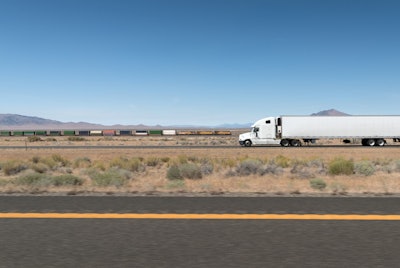
NACFE recently released a new report on the potential for railroads and trucking firms to reduce operating costs and improve emissions by improving utilization of intermodal rail and truck services.
Trucks have won the lion’s share of freight hauling in North America over the last 50 years. There are a number of reasons for that, one of which is viewing rail and truck as competitors rather than partners in a system. That competitive environment has seen railroad trackage steadily decreasing, which impacts where the freight can be moved by rail. At the same time, highway systems have seen dramatic increases in paved lanes. It’s estimated that the six major Class I freight railways have less than 140,000 miles of trackage today while U.S. highways alone exceed 4.1 million miles. Trucks can go nearly everywhere, but trains do not. It seems obvious that trains need trucks. Not so obvious is that trucks need trains — but they do.
Supply and demand for freight movement means there are peaks and valleys. Sometimes there are simply not enough trucks and drivers to move all of North America’s freight. Spot truck freight rates tend to go through the roof at these times. Yet, alternatives exist, moving freight by rail. Rail tends to be a safety valve in peak freight times.
In other economic periods, there simply is too much truck capacity and not enough freight to move. In those bust times, we see a large number of owner-operators failing. Truck freight spot rates fall, and rail alternatives become less competitive.
The peaks and valleys tend to mimic the supply of electricity in the U.S. The infamous “duck curve” of that compares power generation to demand at different times of the day. That curve shows there can be too much generation for the amount of demand during daylight hours, but then dusk comes and demand can exceed supply.
Supply and demand duck curves highlight market volatility. It’s like your need for oxygen. Say you go for a bike ride in the morning, you need more oxygen as you exercise. Then later you may be sitting in your office or on a couch and you don’t need as much. Freight movement, like your need for oxygen, is a constantly moving target.
Mitigating the peaks and valleys of supply and demand tends to reduce overall system costs. The smaller the gap between the peak and the valley, the less infrastructure is needed to deal with the worst cases. This is true for power generation and true for the freight system.
Increasing use of railroads in moving freight has a moderating effect on volatility. Focusing rail on long distance hauls where it clearly has fuel economy advantages, while getting trucks to do the first and final mile hauling, has the potential to minimize freight supply and demand troughs. A more stable and predictable freight system using both rail and truck means lower operating costs for all.
Optimizing intermodal utilization by combining zero-emission trucks in the first and final mile, with improved low- or zero-emission locomotives hauling in the middle mile can reduce the nation’s overall freight environmental footprint.
Increasing the use of intermodal is not an instantaneous option. Railroads have lost a great deal of business to trucking over 50 years for many market-based reasons, and those challenges need to be overcome. Reliable customer service has to be demonstrated to win back freight to railways. This means dramatically improving on-time performance, reducing incidents like derailments, and reducing lost time due to freight transfers between railroads and between railroads and trucks.
Breaking the boom-and-bust cycles in freight requires a freight system perspective where all the tools in the tool box are included in the solution. Ask yourself, why are containers being transloaded at ports from 40-foot ocean going containers to 53-foot domestic rail containers? Why are containers driven by truck from the ports of Los Angeles to Phoenix, or from Houston to inland cities as far away as Oklahoma City or St. Louis? Why do ships from China find it economically viable to sail all the way to the U.S. East Coast to deliver containers?
The focus needs to be on improving freight efficiency across the board, not perpetuating a truck versus train paradigm. Clearly, both trucks and trains need each other as we move towards greater cost reduction and emissions mitigation.










